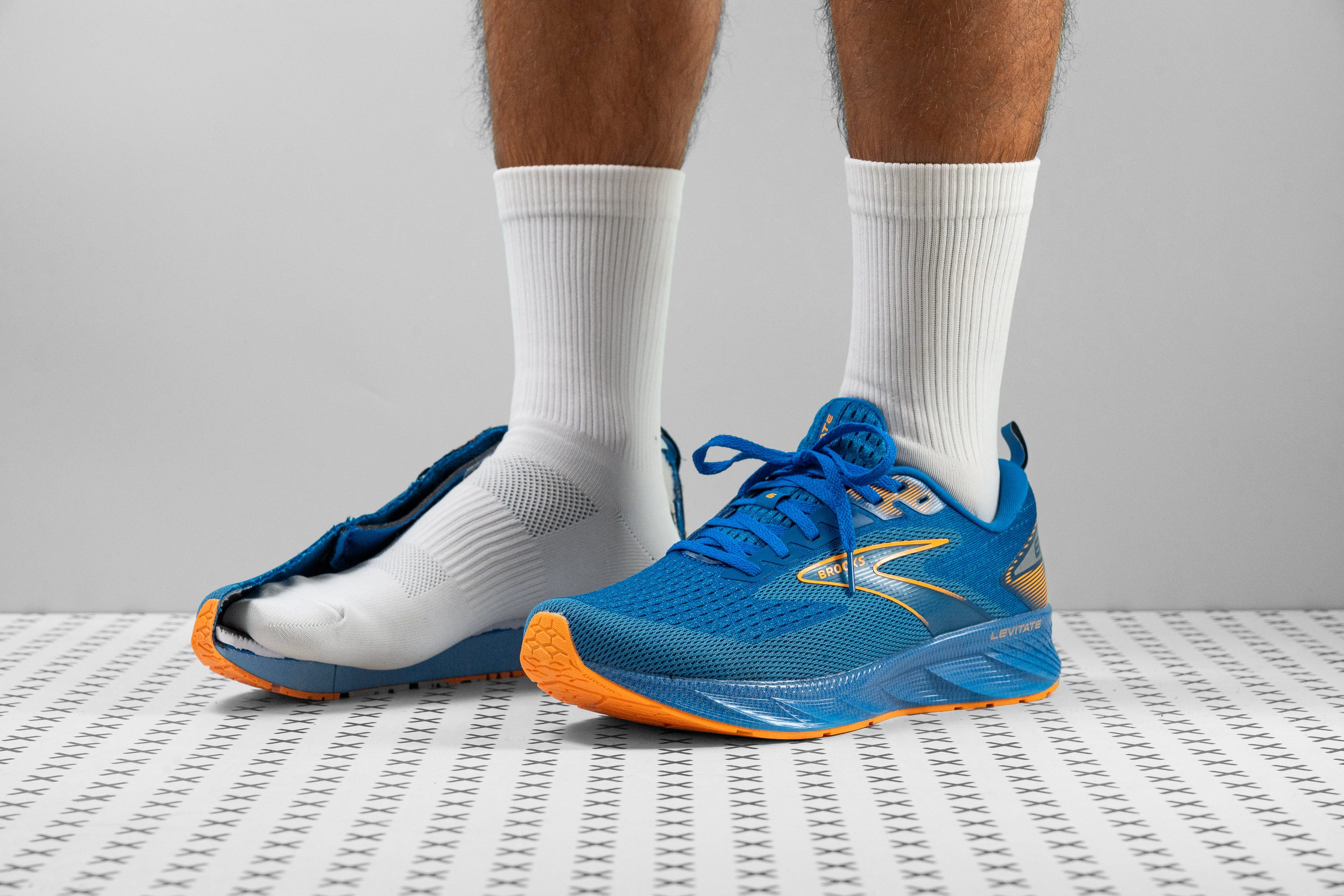Our verdict
Pros
- Great impact dampening
- Fun and springy ride
- Good for long distances
- Responsive and capable at high paces
- Extremely breathable
- No break-in period required
- Comfortable and durable upper construction
- Supportive structure provides secure lockdown
- Grippy and resilient outsole
- Consistent performance all year round
Cons
- Could be lighter
- Not for wide feet
- Pricey for a daily trainer
Audience verdict
- Top 22% in road running shoes
- Top 11% in Brooks running shoes
Comparison
The most similar running shoes compared
+ + Add a shoe | |||||
|---|---|---|---|---|---|
| Audience score | 90 Superb! | 90 Superb! | 88 Great! | 86 Good! | |
| Price | $150 | $130 | $150 | $160 | |
| Pace | Daily running | Daily runningTempo | Daily running | Daily running | |
| Arch support | Neutral | Neutral | Neutral | Neutral | |
| Weight lab Weight brand | 10.7 oz / 304g 10.9 oz / 309g | 8.6 oz / 245g 8.4 oz / 238g | 9.7 oz / 275g 9.8 oz / 277g | 10.3 oz / 293g 10.6 oz / 300.5g | |
| Lightweight | ✗ | ✓ | ✗ | ✗ | |
| Drop lab Drop brand | 7.7 mm 8.0 mm | 8.2 mm 9.0 mm | 8.5 mm 10.0 mm | 8.1 mm 8.5 mm | |
| Strike pattern | Mid/forefoot | HeelMid/forefoot | HeelMid/forefoot | HeelMid/forefoot | |
| Size | True to size | Half size small | True to size | True to size | |
| Midsole softness | Soft | Balanced | Balanced | Balanced | |
| Difference in midsole softness in cold | Small | Small | Small | Small | |
| Toebox durability | Good | Bad | Decent | Good | |
| Heel padding durability | Good | Good | Decent | Decent | |
| Outsole durability | Good | Decent | Decent | Good | |
| Breathability | Breathable | Breathable | Moderate | Moderate | |
| Width / fit | Narrow | Wide | Medium | Medium | |
| Toebox width | Medium | Medium | Medium | Medium | |
| Stiffness | Stiff | Moderate | Stiff | Stiff | |
| Torsional rigidity | Moderate | Moderate | Moderate | Stiff | |
| Heel counter stiffness | Moderate | Flexible | Stiff | Moderate | |
| Heel lab Heel brand | 34.3 mm 32.5 mm | 34.9 mm 35.0 mm | 33.6 mm 39.0 mm | 32.1 mm 30.5 mm | |
| Forefoot lab Forefoot brand | 26.6 mm 24.5 mm | 26.7 mm 26.0 mm | 25.1 mm 29.0 mm | 24.0 mm 22.0 mm | |
| Widths available | Normal | NormalWide | NormalWide | Normal | |
| Orthotic friendly | ✓ | ✓ | ✓ | ✓ | |
| Season | SummerAll seasons | SummerAll seasons | All seasons | All seasons | |
| Removable insole | ✓ | ✓ | ✓ | ✓ | |
| Ranking | #75 Top 21% | #46 Top 13% | #126 Top 35% | #192 Bottom 47% | |
| Popularity | #256 Bottom 30% | #169 Top 46% | #77 Top 21% | #317 Bottom 13% |
Who should buy
We recommend the Levitate 6 as a great choice for:
- Neutral runners looking for a plushly cushioned daily trainer with a bouncy ride
- Runners who want a one-and-done, versatile shoe that can gracefully tackle easy runs, speedy sessions, as well as long distances.
- Those living in colder climates for whom the shoe will feel consistent and comfortable all year round.
Who should NOT buy
The Levitate 6 is heavier than it needs to be. Many modern running shoes of similar or greater stack heights manage to come out significantly lighter. The ASICS Superblast is an extreme example of this with its gargantuan 42.7 mm heel stack coming in at a surprisingly svelte 8.6 oz/244g (a fact made up for by its heavy price tag).
For another daily trainer that provides a similarly bouncy ride but feels more cloud-like in the weight department, we vouch for On Running’s Cloudsurfer 7 as an alternative.
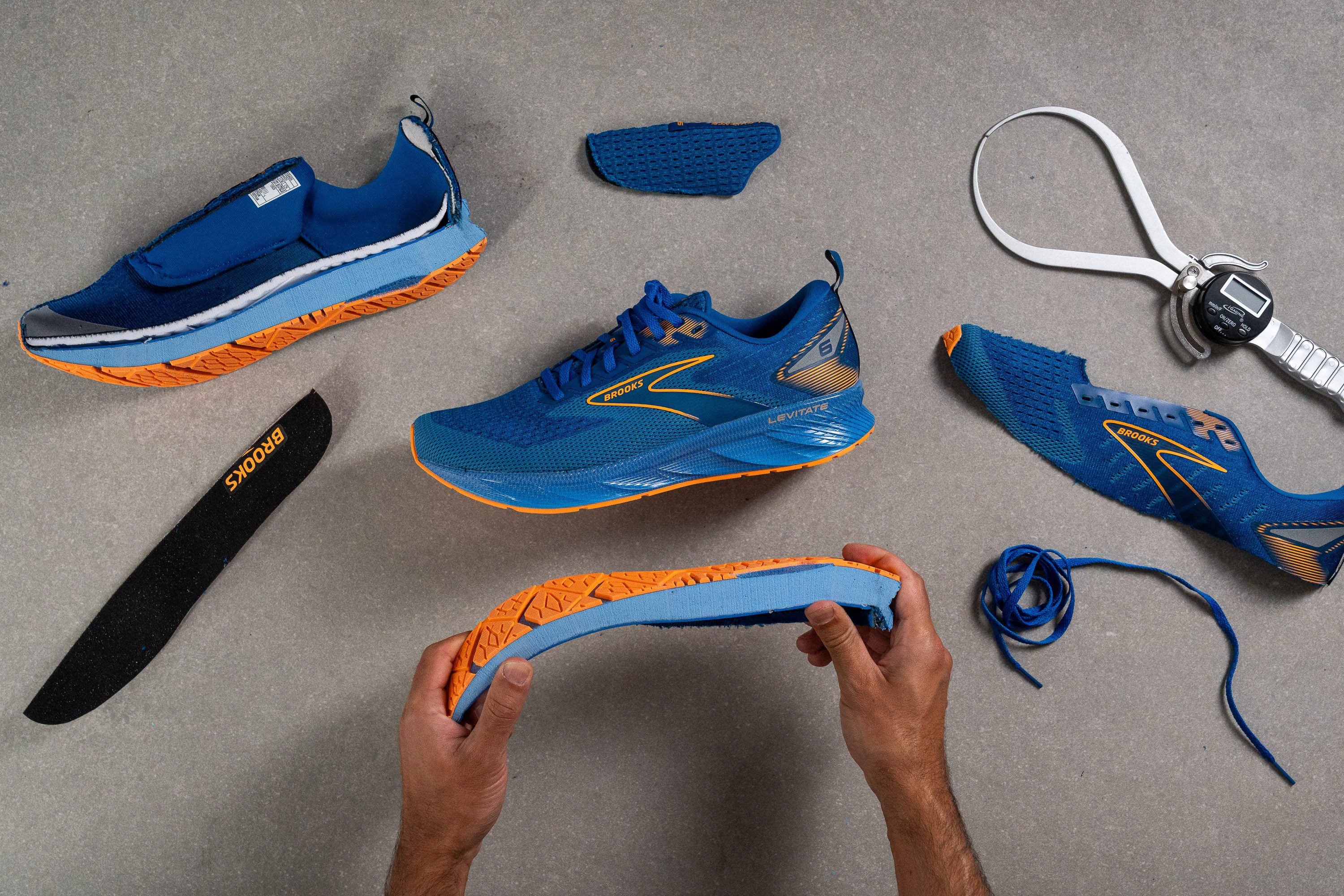
While the Levitate 6 isn’t narrow per-se, runners with wide feet will benefit from a roomier toebox. It likely won’t be an issue during easier runs, but the shoe’s well-structured upper constructruction won’t accommodate much foot swelling in the latter half of long distance runs. For those broad-footed runners, we suggest having a look at the more spacious Saucony Triumph 21 instead.
Cushioning
Heel stack
Using our caliper, we measured the Levitate 6’s stack to be 34.3 mm high at the heel. This is slightly higher than average and a couple millimeters more than 32.5 mm in the official specs by Brooks. This disparity is small and might be accounted for by the fact that we include the insole as part of our measurements.
This is a good amount of foam underfoot that ensures heel strikers will enjoy well cushioned landings over any distance.

| Levitate 6 | 34.3 mm |
| Average | 34.8 mm |
Forefoot stack
Moving up to the forefoot, the Levitate 6’s stack measures a healthy 26.6 mm thick which is slightly more foam underfoot than our current lab average. This means that forefoot strikers will benefit from protective landings that feel as cushy as for their heel striking counterparts, whether out for an easy 5K or a stamina challenging long distance effort.
For runners who prefer a more natural feeling daily trainer that provides more ground-feel, we recommend the speedy Brooks Hyperion, or the always reliable Nike Pegasus 40 instead.
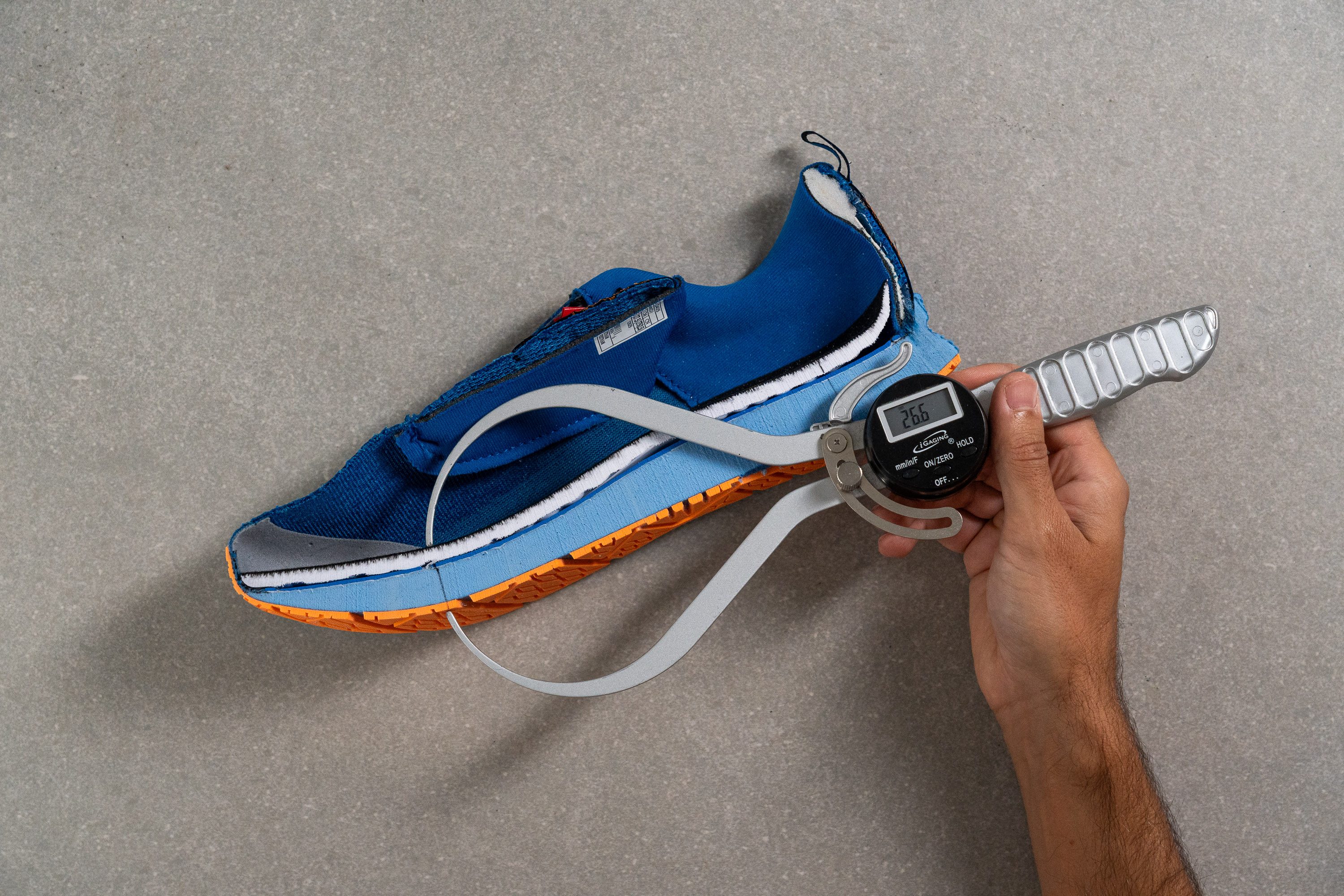
| Levitate 6 | 26.6 mm |
| Average | 26.2 mm |
Drop
We have to laud Brooks for the accuracy of their stated 8 mm heel drop. We turned up a drop of 7.7 mm which makes the disparity negligible. This isn’t always the case as many manufacturers (even Brooks) frequently misjudge their drop heights, leading to confusion and, at worst, injury as this article explores.
This mid-level heel drop is favorable for daily trainers as it’s rather neutral and caters to a wide variety of runners, whether heel or forefoot striking.
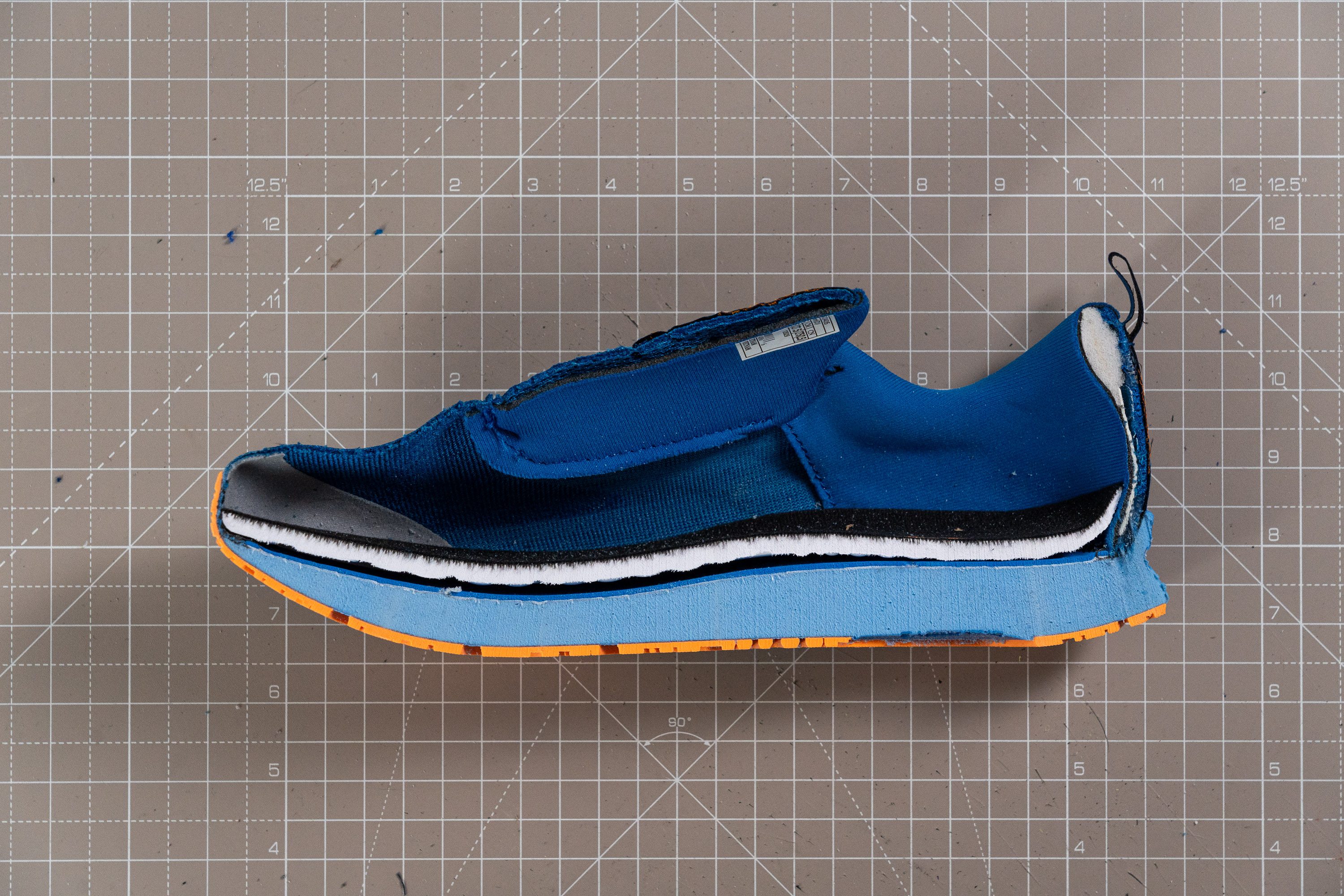
| Levitate 6 | 7.7 mm |
| Average | 8.6 mm |
Midsole softness
Onto midsole softness and the return of our reliable durometer. The updated DNA AMP foam is definitely the main attraction of the Levitate 6. With a reading of 19.8 HA, it’s quite a bit softer than the average road shoe.
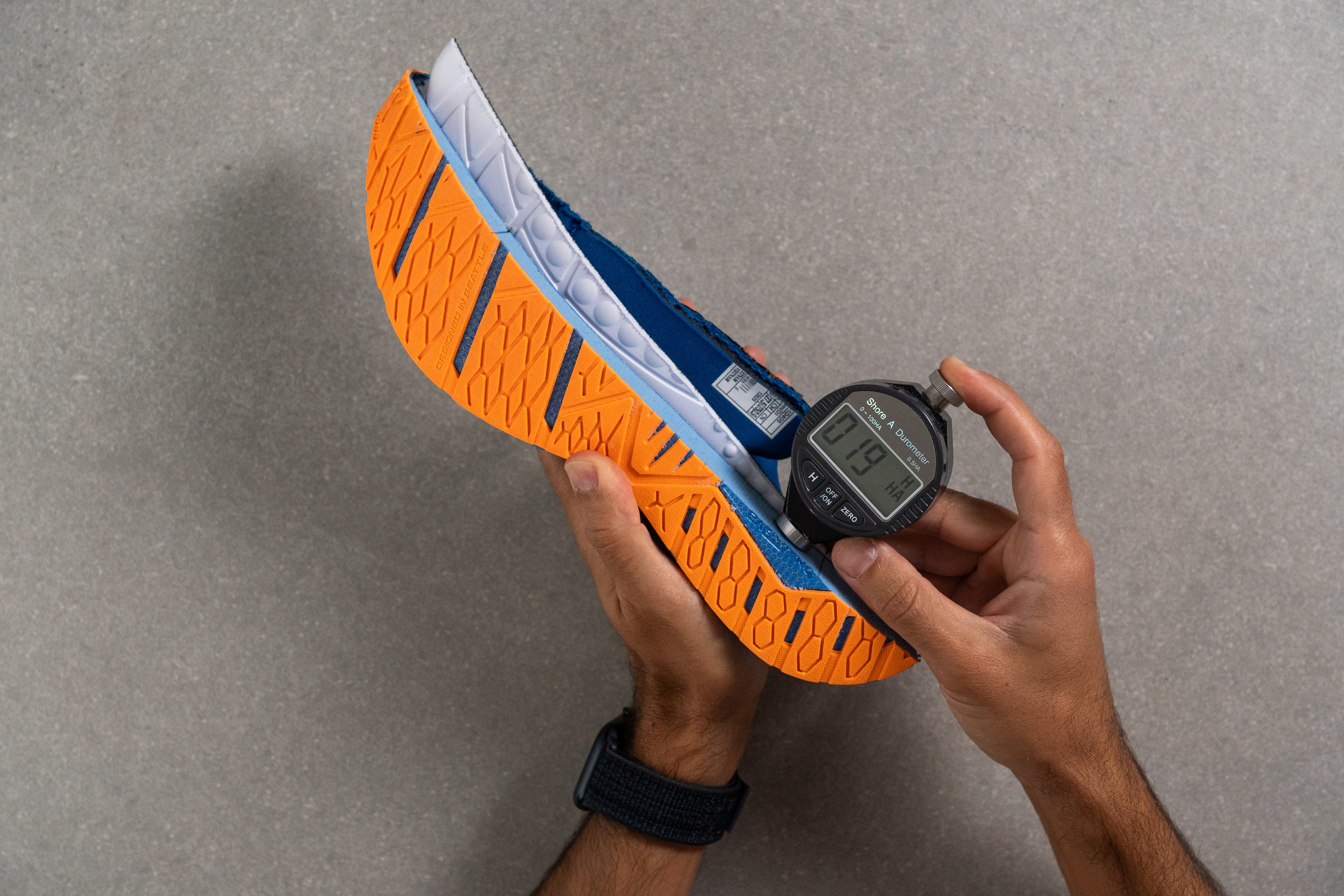
We shouldn’t conflate softness with mushiness, however, in the case of the Levitate 6. The midsole cushioning feels well-balanced; with a springy rebound that feels energetic enough for high paces while also feeling pleasantly cushy and protective for longer efforts.
| Levitate 6 | 19.8 HA |
| Average | 20.4 HA |
Size and fit
Size
Brooks Levitate 6 fits true to size (17 votes).
Width / Fit
Measuring the Levitate 6’s toebox with our caliper, we found it isn’t as roomy as the average road shoe at its widest point, measuring only 96.6 mm wide. While this isn’t toe-crushingly narrow, it means that this shoe definitely won’t be a favorite for runners with wide feet.
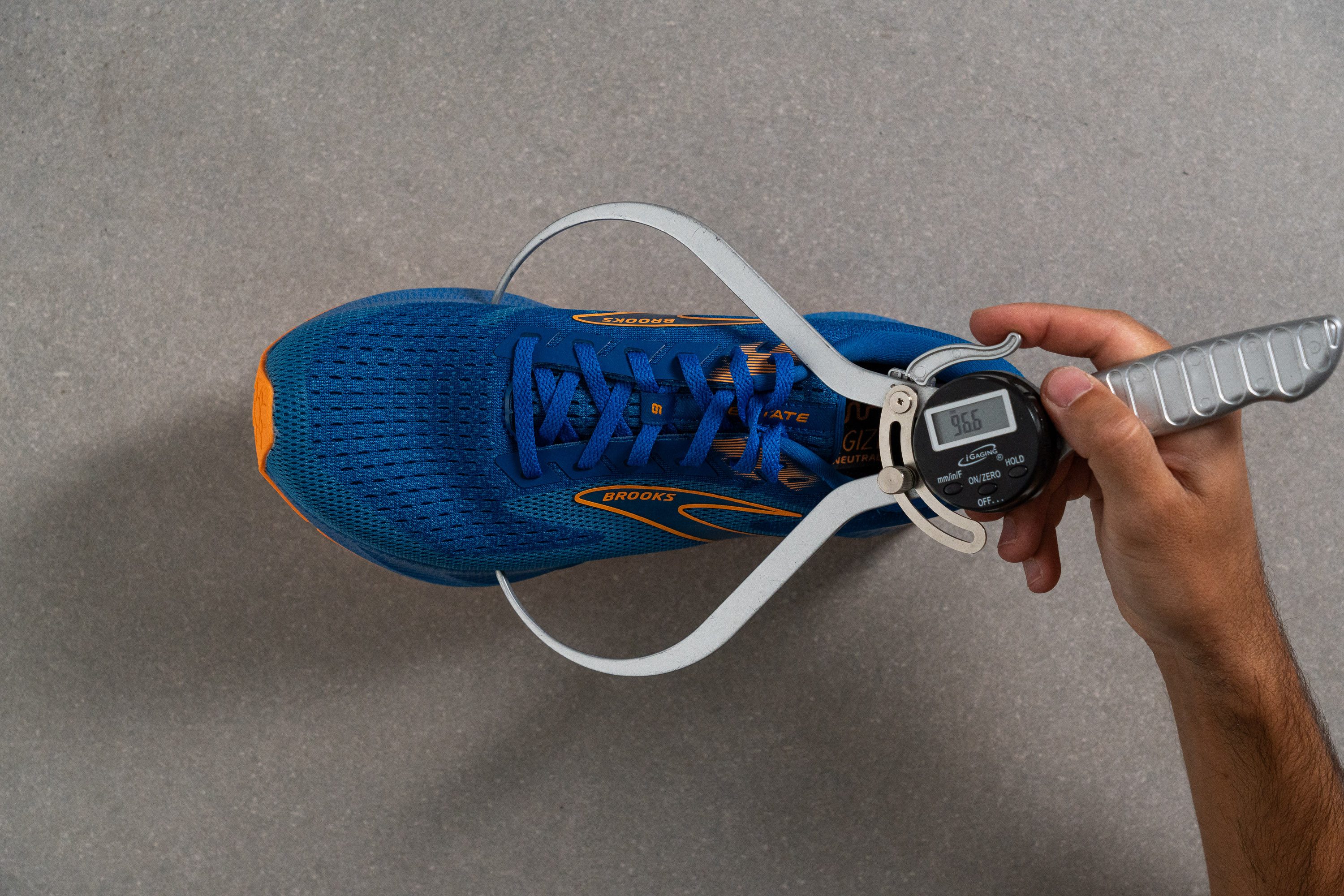
This test follows an older methodology, which is why you don't see recently tested shoes in the chart. Results from different methodologies can not be compared.
| Levitate 6 | 96.6 mm |
| Average | 98.5 mm |
Toebox width
The Levitate 6 doesn’t taper as aggressively towards the big toe as the average road shoe, with our caliper measuring that part of the toebox to be 78.3 mm wide. This gives the shoe a more natural foot-shaped silhouette that allows us to splay out quite comfortably within the shoe.
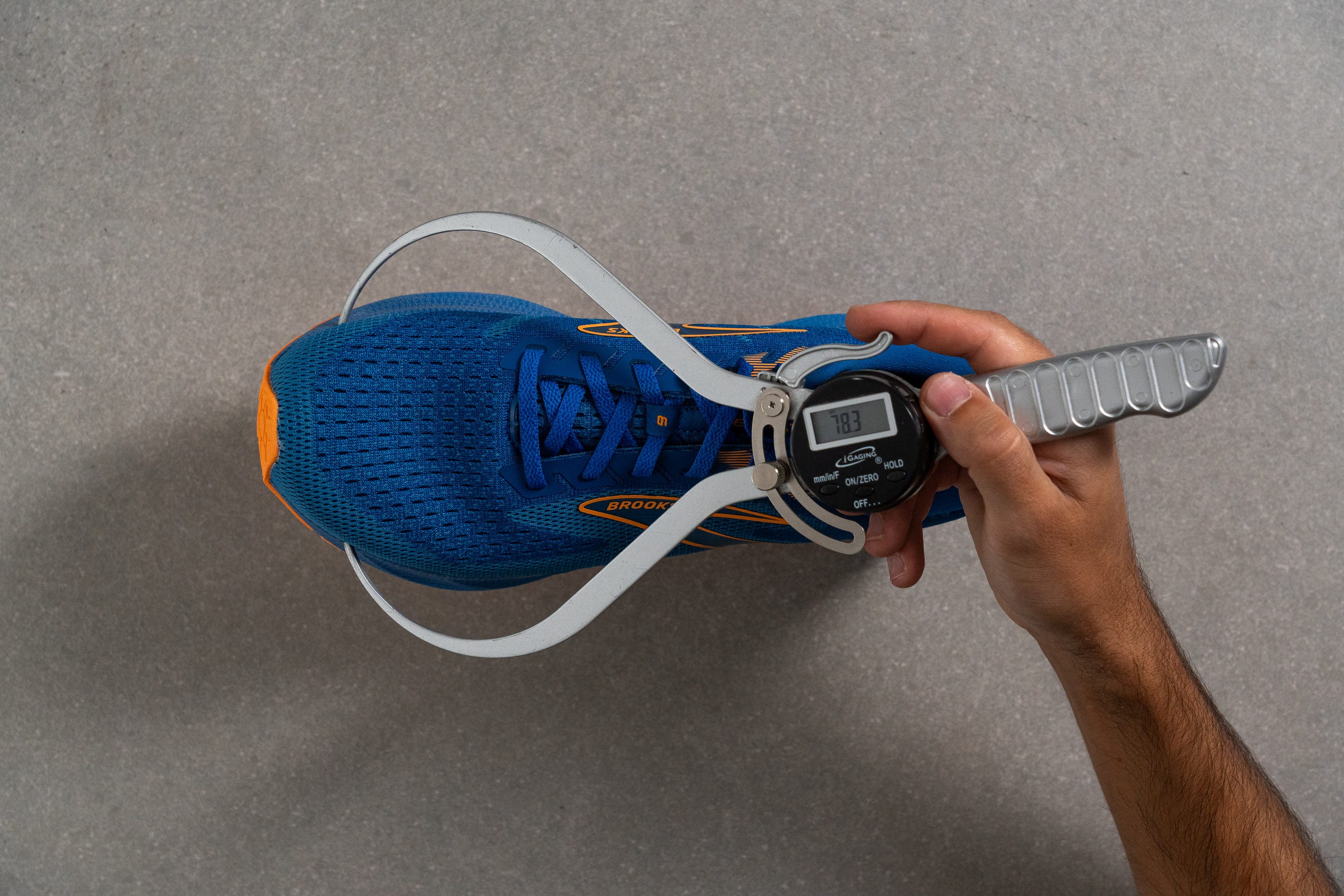
Though again, runners with broad feet will likely suffer from occasional hotspots or blisters in this shoe.
This test follows an older methodology, which is why you don't see recently tested shoes in the chart. Results from different methodologies can not be compared.
| Levitate 6 | 78.3 mm |
| Average | 78.4 mm |
Flexibility / Stiffness
We secured the Levitate 6 to our workbench and measured the amount of force required to bend the shoe 90-degrees. With a result of 24N, the Levitate 6 is significantly more flexible than the average road shoe.
This level of longitudinal flexibility plays a great part in the shoe’s overall comfort, with the Levitate 6 easily able to conform with the natural bending of our foot as we transition from landing to toe-off.
This test follows an older methodology, which is why you don't see recently tested shoes in the chart. Results from different methodologies can not be compared.
| Levitate 6 | 24.0N |
| Average | 28.1N |
Stiffness in cold (%)
We also re-tested the Levitate 6’s flexibility after leaving it in the freezer for twenty minutes and were similarly impressed by the result! With 29.3N of force now needed to bend the shoe to the desired point, the Levitate 6 isn’t just more flexible than the average shoe under similar conditions, but at room temperature too!
This further confirms how comfy and reliable the Levitate 6 is as a year-long training partner, whether during toasty summer runs or bitterly cold winter sessions.
Becoming only 22.1% more stiff in the cold, the Levitate 6 is much more consistent than the average road shoe between warm and cold conditions.
| Levitate 6 | 22% |
| Average | 33% |
Weight
Speaking of which, the Levitate 6 tips the scale at a rather chunky 10.73 Oz (304g). Many shoes of similar and higher stack heights turn out lighter, with the Levitate 6 falling more on par with stability shoes that tend to boast more structured and weighty constructions.
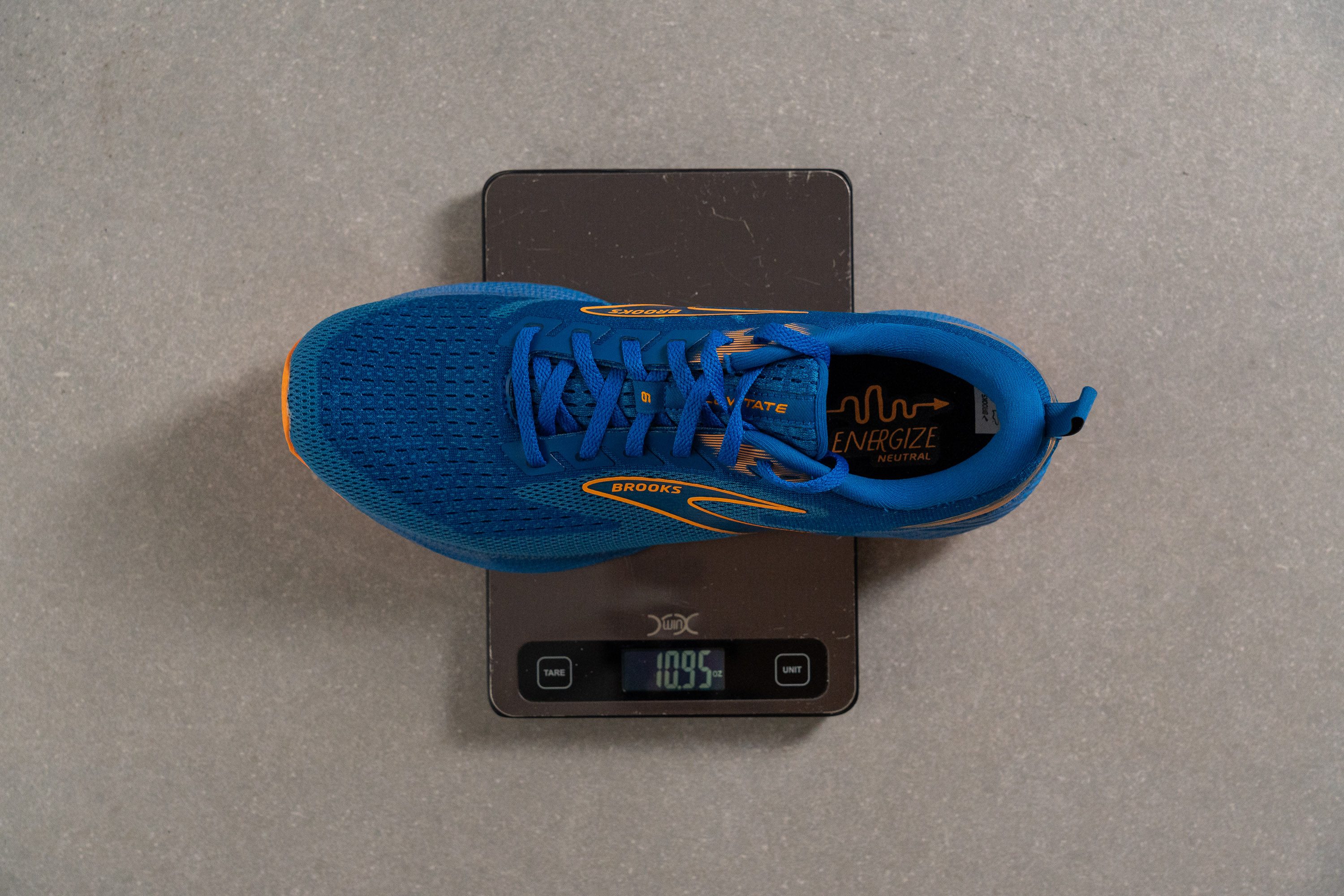
For what it’s worth, the Levitate 6 isn’t THAT heavy; it’s springy ride means that it definitely doesn’t feel overly brickish or burdensome underfoot, but, in our humble opinion, a diet would make this shoe perform exponentially better. This feat isn’t beyond the capabilities of Brooks who nailed it with their feathery speed freak, the Hyperion (7.44 oz/211g) and the lightweight, mile-gobbling Launch 10 (8.11 oz/230g).
| Levitate 6 | 10.7 oz (304g) |
| Average | 9.3 oz (264g) |
Breathability
To test the shoe’s airflow, we put the Levitate 6 through our breathability test where we pump it full of smoke to simulate foot heat. The tongue immediately billows out plumes of smoke while the toebox steadily churns out a blanket of mist that tells us that ventilation certainly isn’t lacking in this shoe. The Levitate 6 easily earns a score of 5 out of 5 for breathability.
When we examine a backlit cross section of the upper, we can see that the soft knit portion around the toebox is quite opaque and blocks out most of the light. This is starkly contrasted by the engineered mesh that runs the lateral side which allows the light to happily shine through.
Even the knit portion of the upper, while densely woven, is well perforated with a more airy layer beneath as our closeup images reveal. So while this section is a little cozier, it still promotes adequate airflow. This slightly warmer portion of the shoe also means the Levitate 6 is a good training partner for those frosty winter runs.
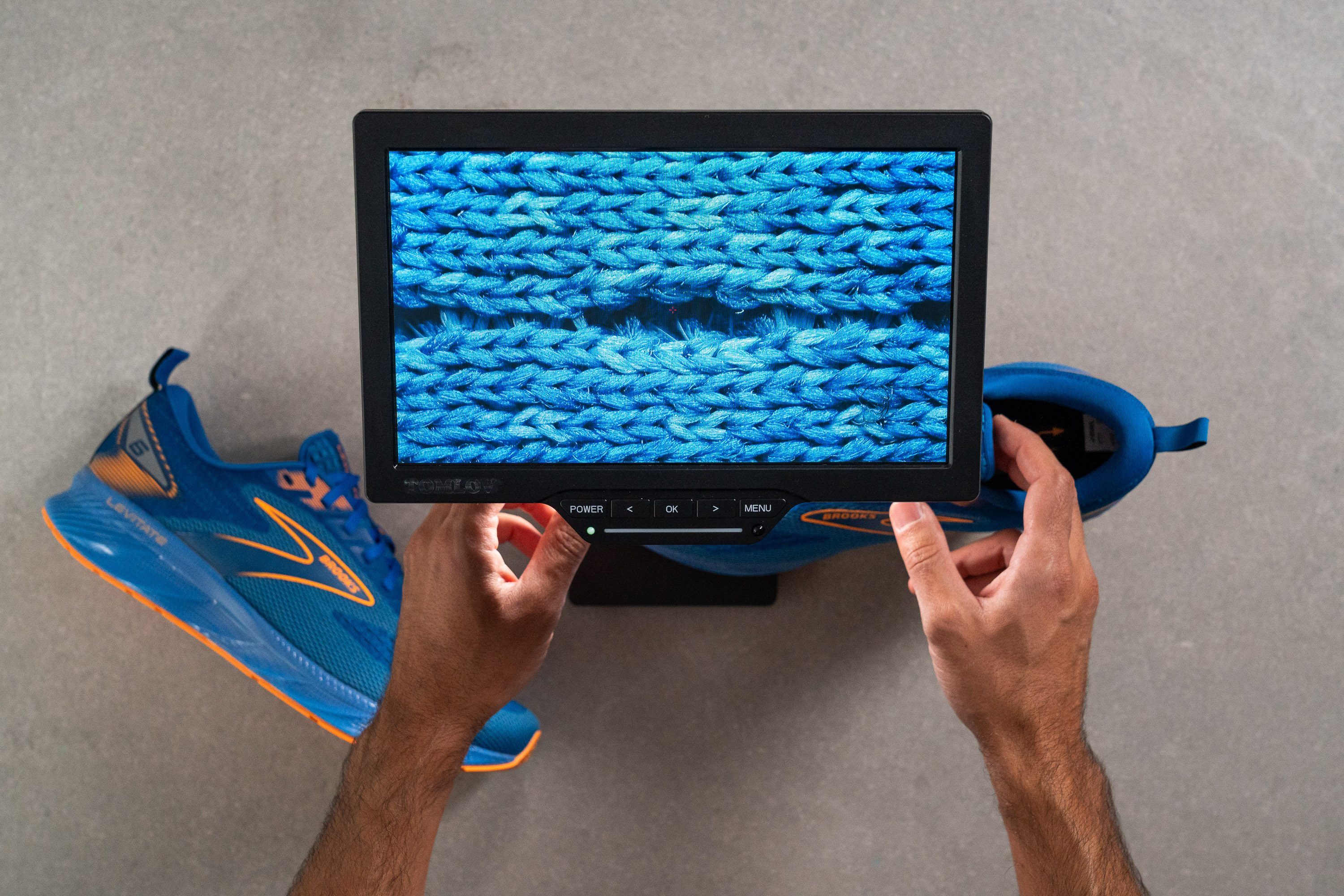
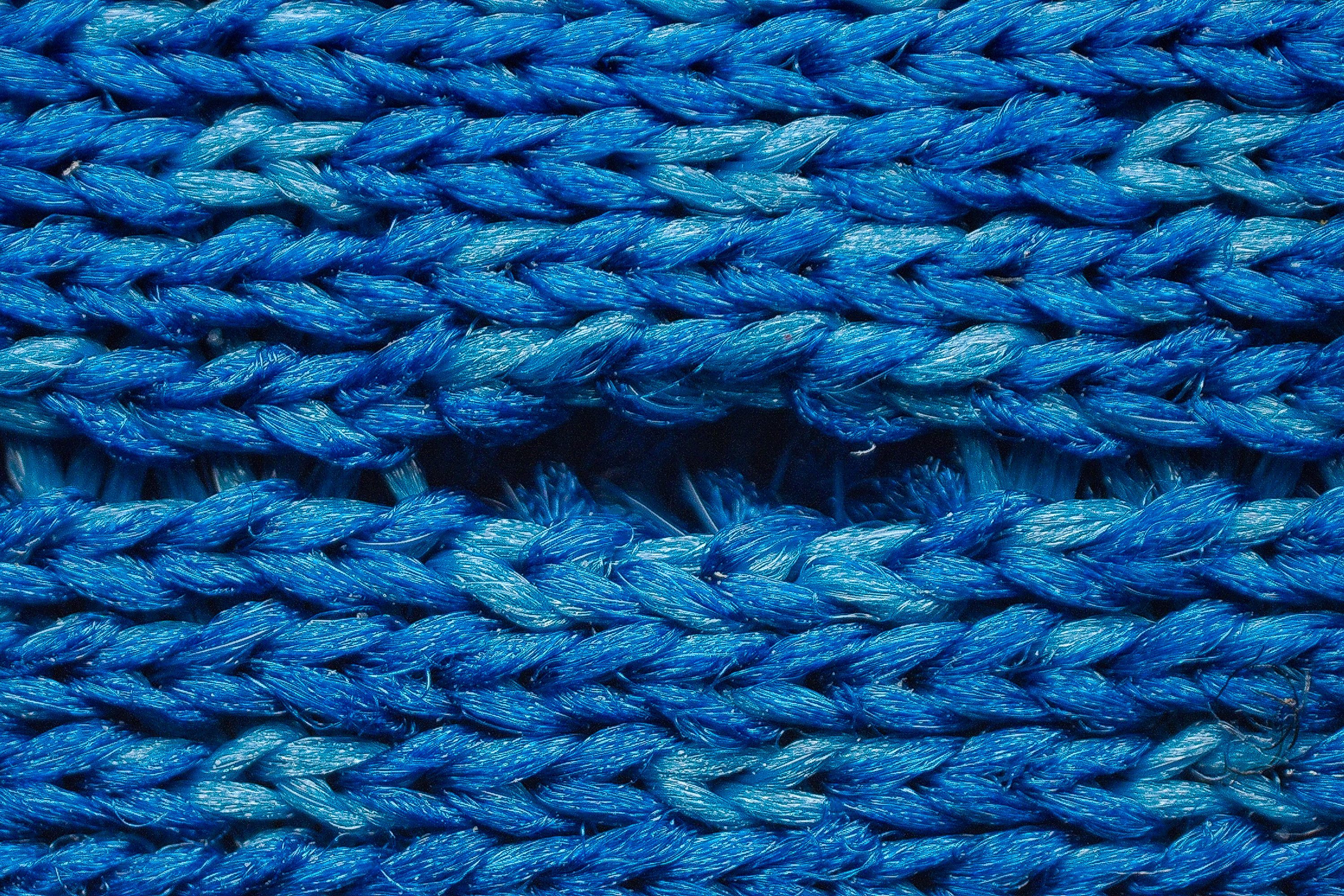
| Levitate 6 | 5 |
| Average | 3.7 |
Stability
Lateral stability test
As a neutral shoe that sits on a high stack with lots of plush foam underfoot, we didn't expect much in terms of stability from the Levitate 6. Though, for what it’s worth, we felt more well planted than we had anticipated when we shifted our weight from side to side in the shoe.
This is good enough for neutral runners, but for those with pronounced pronation in their stride we recommend checking out a shoe with added stability features like the Brooks Adrenaline GTS 23.
Torsional rigidity
We bent and twisted the Levitate 6 in our hands and faced a moderate level of resistance to our manual manipulations, leading us to give the shoe a middle-of-the-road score of 3 out of 5 on our subjective scale for torsional rigidity.
This level of rigidity allows the shoe to somewhat conform with the natural movements of our foot while still providing a landing surface that feels relatively level and stable as we run.
| Levitate 6 | 3 |
| Average | 3.5 |
Heel counter stiffness
The heel counter also feels moderately stiff, earning a score of 3 out of 5 after we pinched and squeezed it with our hands. In practical terms; the heel counter does a pretty good job holding our rearfoot in place, but our foot was still able to move quite naturally within the shoe.
| Levitate 6 | 3 |
| Average | 2.9 |
Midsole width - forefoot
We measured the Levitate 6’s midsole to be 114.7 mm wide at the forefoot, which is only slightly wider than our current lab average. This gives forefoot strikers a broad enough base for stable landings and toe-offs, while avoiding being so wide as to feel blocky on corners.
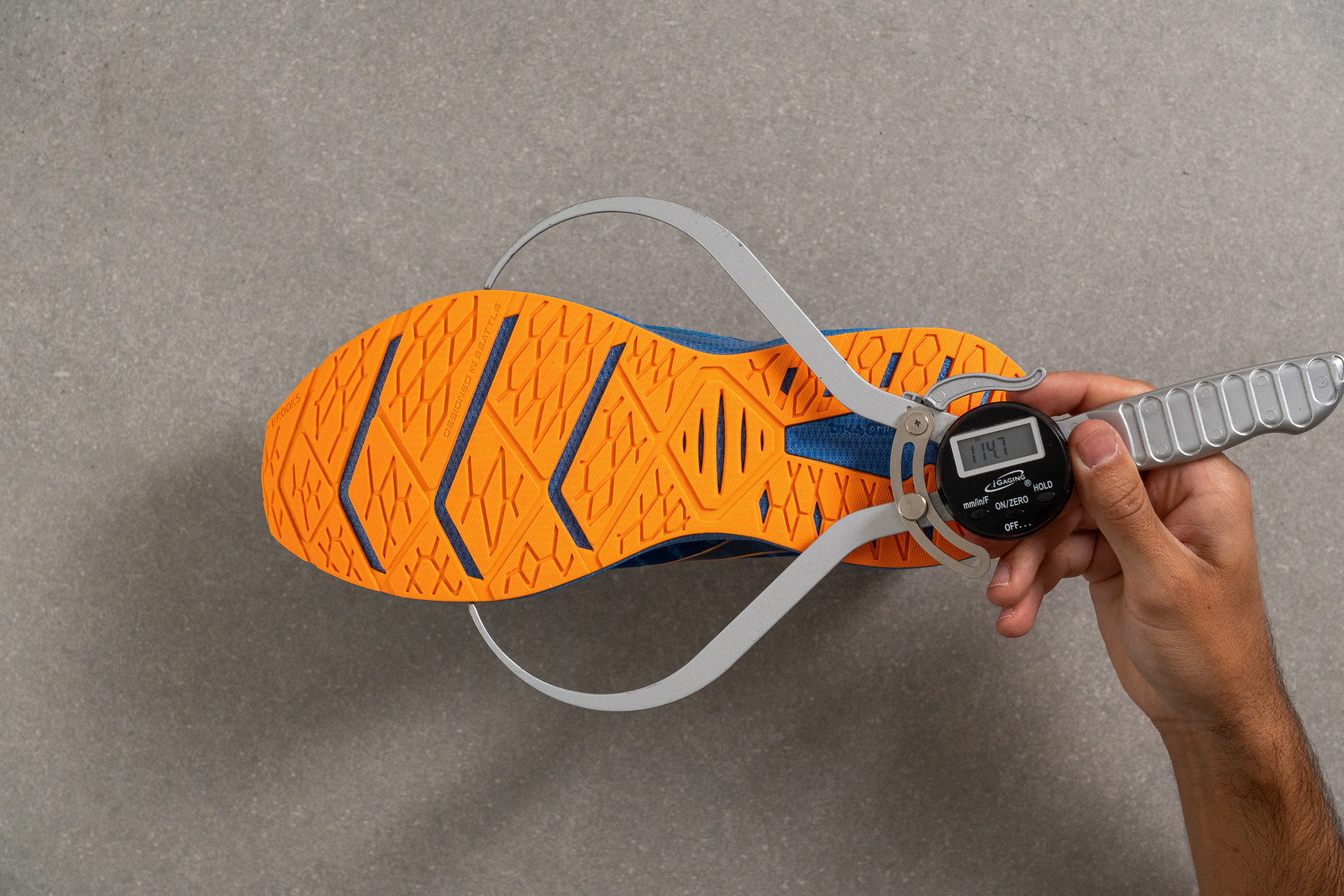
| Levitate 6 | 114.7 mm |
| Average | 114.3 mm |
Midsole width - heel
Moving down to the heel, it turned out a little narrower than average at 87.5 mm wide according to our caliper. This shouldn’t be an issue for heel strikers with a neutral stride for whom the shoe will still provide an adequately stable landing platform.
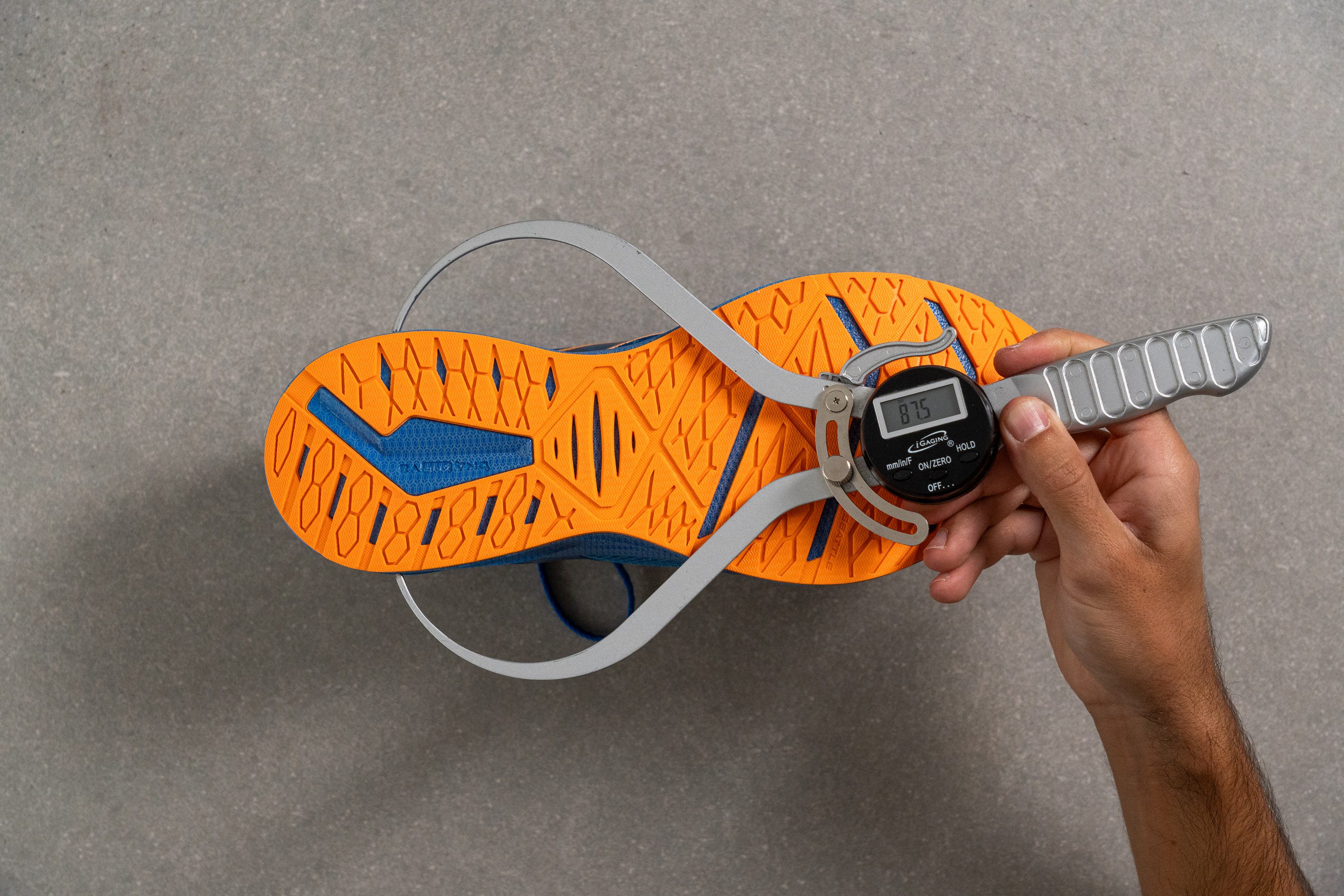
For pronating runners, however, we suggest looking at a shoe with a more substantial heel for steady landings like the Brooks Glycerin 20 as a neutral option or its stability counterpart, the Glycerin GTS 20, for runners with more pronounced pronation.
| Levitate 6 | 87.5 mm |
| Average | 90.7 mm |
Durability
Toebox durability
To simulate extreme wear and tear, we put the shoe through the battery of durability tests, starting with the toebox. Our Dremel test is usually a dramatic affair with material being shredded by the tool’s relentless grinding element. This is far from the case with the Levitate 6 which boldly withstands the four second test with a small shred of material rolled to the side.
Clearly the damage isn’t very extensive as the Dremel barely made it all the way through the knit upper, with only a small hole poking all the way through. We therefore give the Levitate 6 an impressive toebox durability score of 4 out of 4.
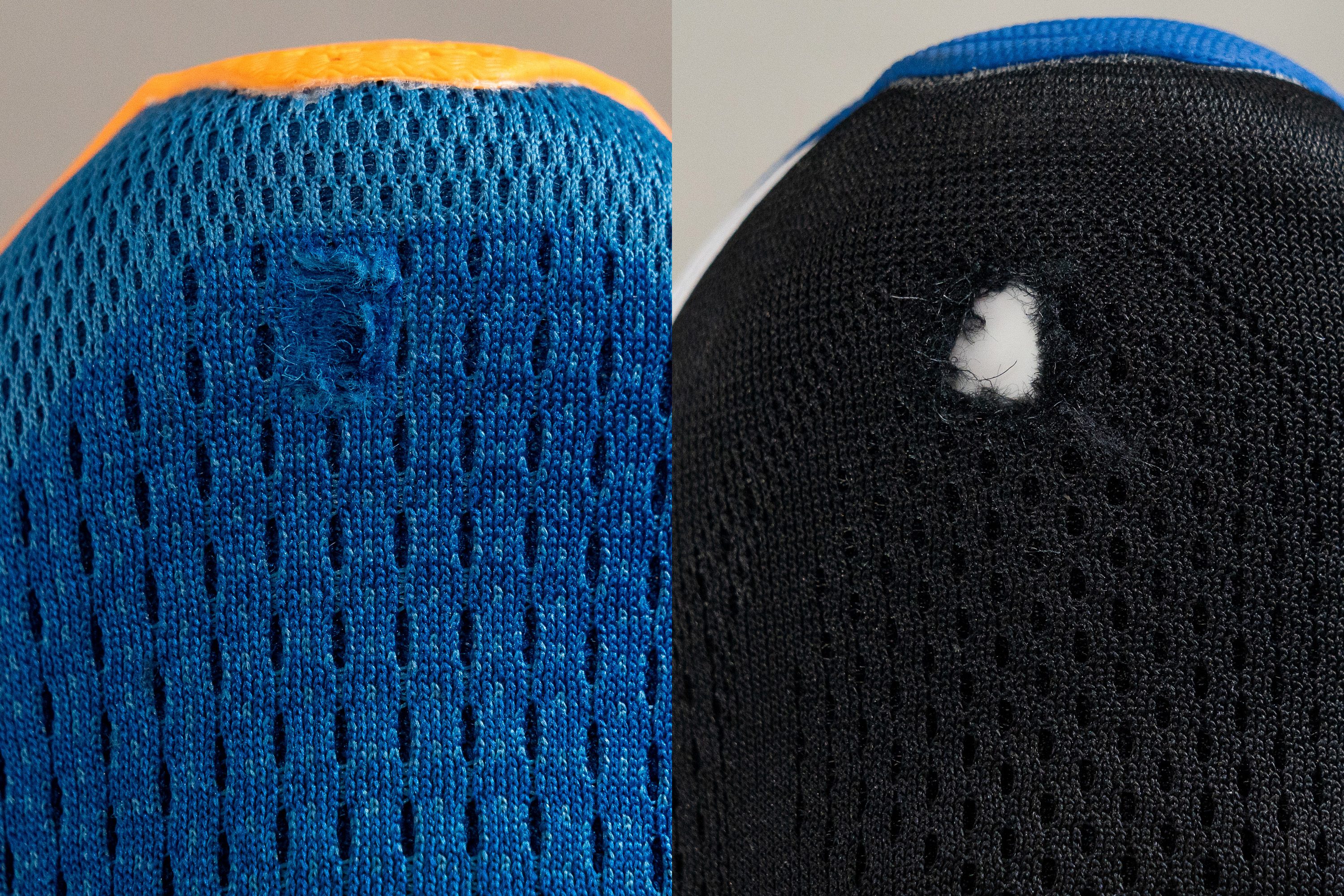
| Levitate 6 | 4 |
| Average | 2.6 |
Heel padding durability
Our Dremel was again thwarted by the durability of the Levitate 6’s heel collar, which proved to be among the tools' worthiest opponents so far. Beyond the little fluff that’s immediately cast away at the onset of the test, the tool’s abrasive element seems to have no effect on the shoe.
The aftermath of the test is a scuff that we would hardly even describe as unsightly, so giving the heel padding a perfect durability score was a no-brainer. We therefore expect the heel to look like new even after hundreds of miles of use, sockless or otherwise.
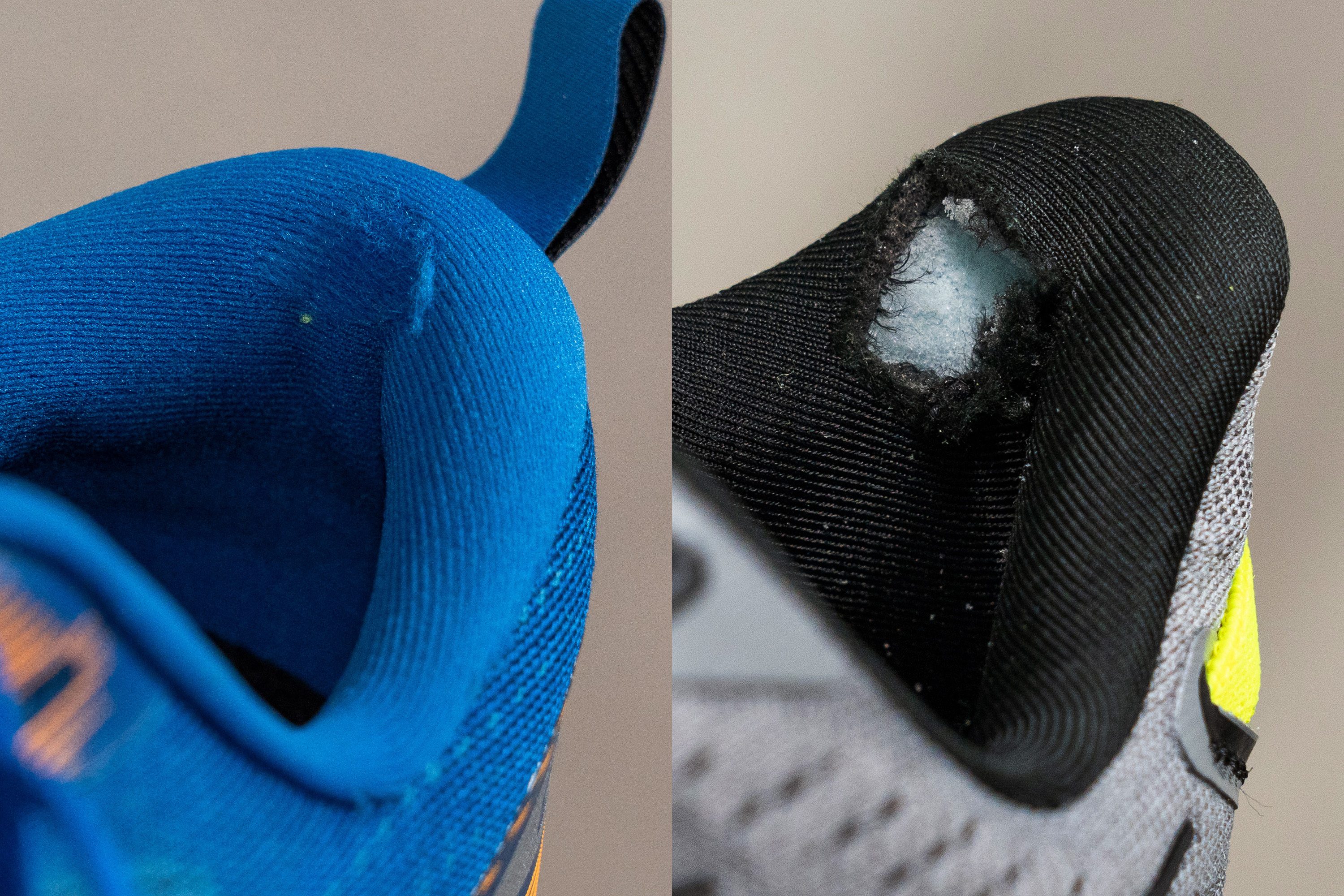
The Saucony Ride 16 clearly didn't fare nearly as well against our Dremel, with a massive crater left in the aftermath of the same test.
| Levitate 6 | 5 |
| Average | 3.4 |
Outsole hardness
To measure the hardness of the outsole, we whipped out our trusty durometer and pressed it against the shoe’s outsole rubber. With a reading of 80.5 HC, the Levitate 6 falls smack-dab in the average range for road shoes. This level of hardness usually provides a good balance of traction and durability, the latter of which will be put to the test in the next section.
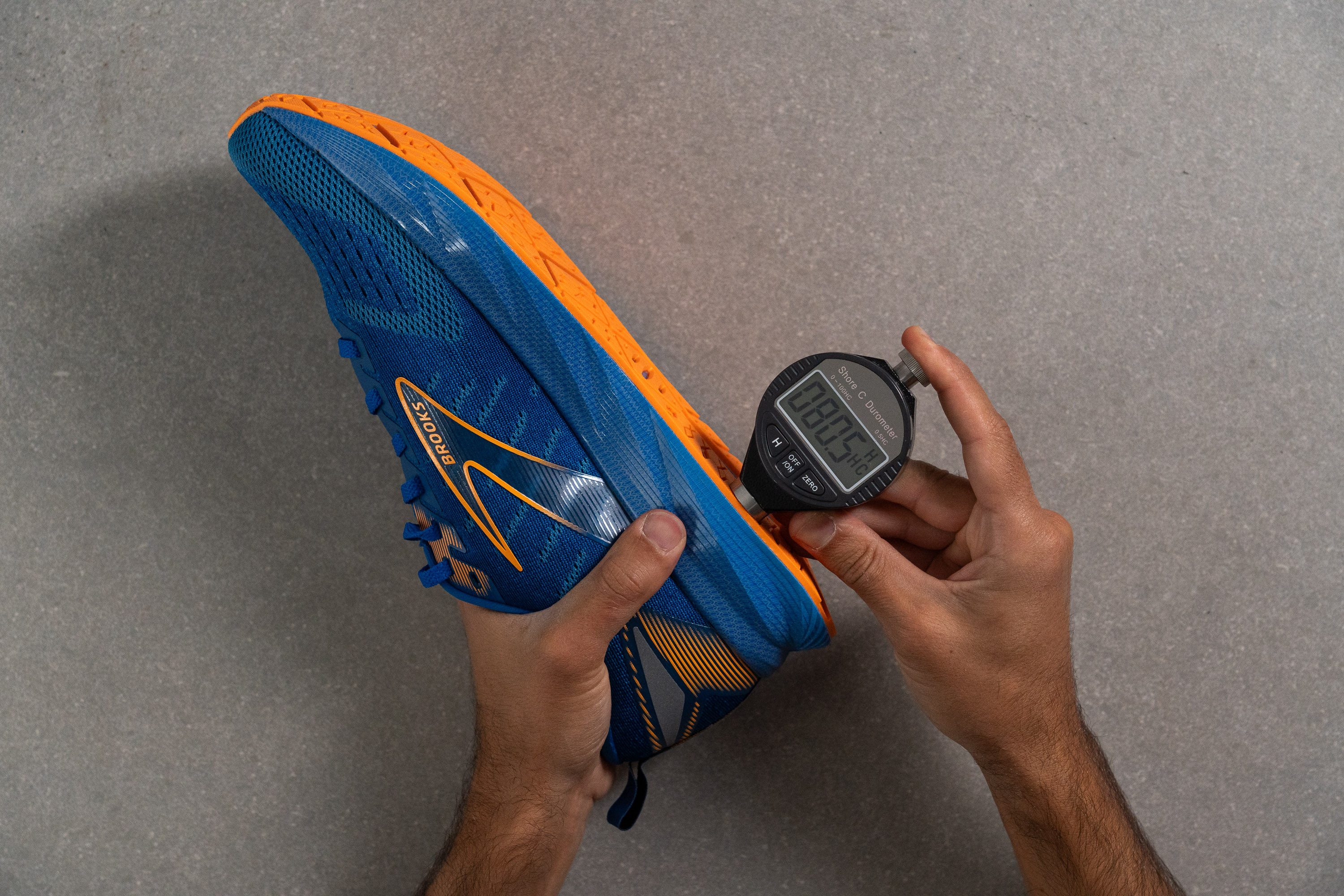
| Levitate 6 | 80.5 HC |
| Average | 79.2 HC |
Outsole durability
Our outsole durability test marks the third and final appearance of our Dremel. As the test wore on, the 3.2N of abrasive force spinning at 10K RPM seemed to get the better of the shoe, with a virtual snowstorm of rubber being immediately kicked up followed by some rather unhealthy looking chunks.
Assessing the damage with our tire gauge, however, our Dremel’s hopes for redemption were dashed when we found that it had only sheared off 0.5 mm of rubber from the outsole. This is a much better result than the average road shoe which loses roughly double that. We therefore predict the Levitate 6’s outsole to look and feel relatively intact after 400-miles of use.
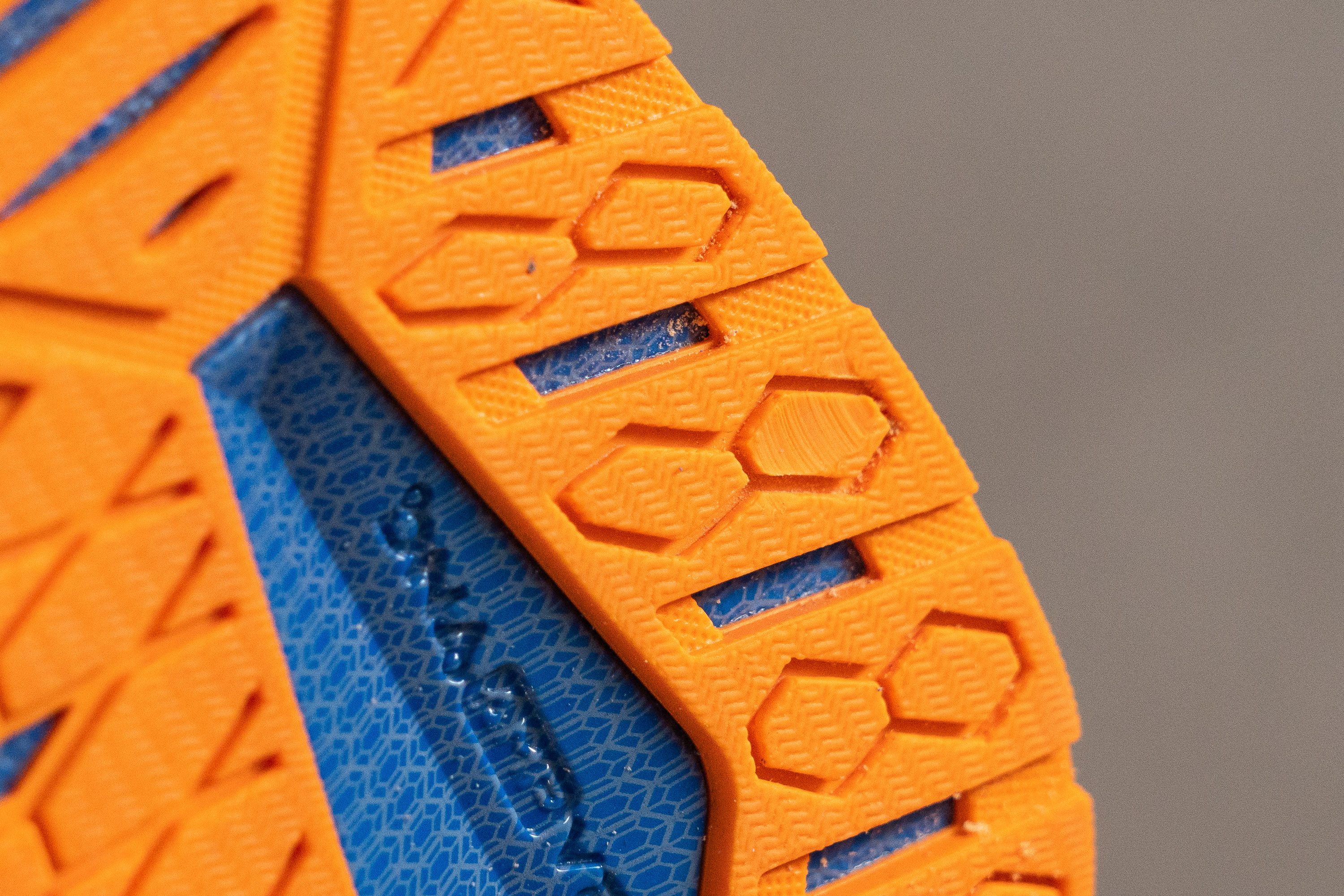
It's like a where's Waldo challenge just to find where our griding element made contact with the outsole!
| Levitate 6 | 0.5 mm |
| Average | 1.1 mm |
Outsole thickness
With 3.5 mm of outsole according to our caliper, the Levitate 6 has an average amount of rubber underfoot. While this gives us added confidence regarding the shoe’s longevity, a little less outsole material would have shed some weight off the shoe without sacrificing too much durability as our last test clearly demonstrates.
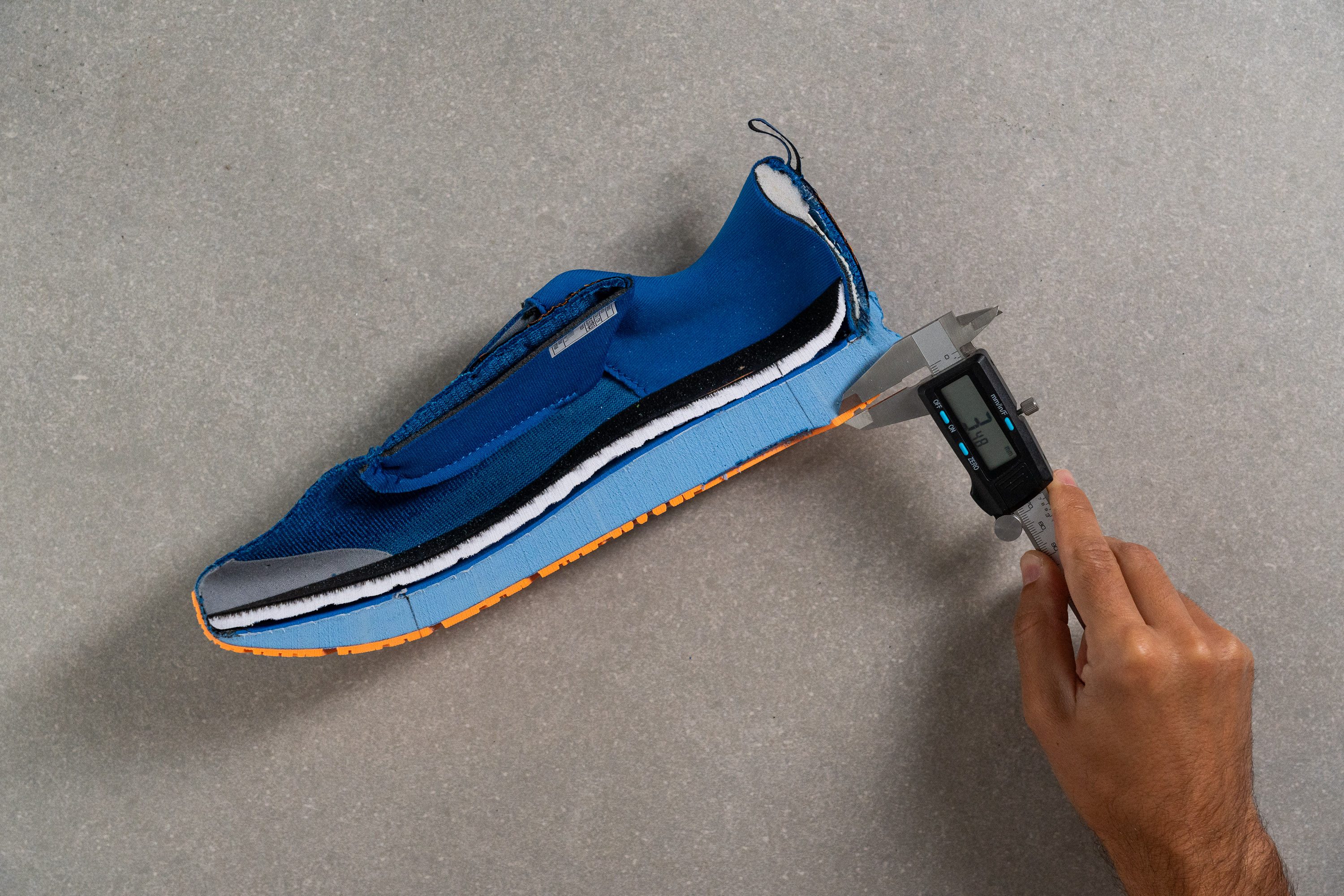
| Levitate 6 | 3.5 mm |
| Average | 3.2 mm |
Misc
Insole thickness
The Levitate 6 features a girthy midsole that our caliper measured to be 5.8 mm thick. This gives our feet a cushier than average surface within the shoe that dampens our landings before the midsole cushioning even kicks in.

| Levitate 6 | 5.8 mm |
| Average | 4.5 mm |
Removable insole
The insole of the Levitate 6 is fully removable, making the shoe compatible with most custom orthotics where necessary.
| Levitate 6 | Yes |
Midsole softness in cold (%)
Ordinarily we expect a midsole to stiffen up when exposed to the cold, but with the Levitate 6, we had to make sure our freezer was still plugged in!
After chilling with our ice cream for twenty minutes, we repeated the previous test and got a marginally more firm durometer reading of 20.8 HA. So expect a ride that remains soft and springy through the frostiest winter runs.
We have to take our hats off to Brooks and their DNA AMP v2 foam as with a mere 5.3% increase in firmness, the Levitate 6 ranks among the best performing shoes in our freezer test. It’s practically impervious to the cold!
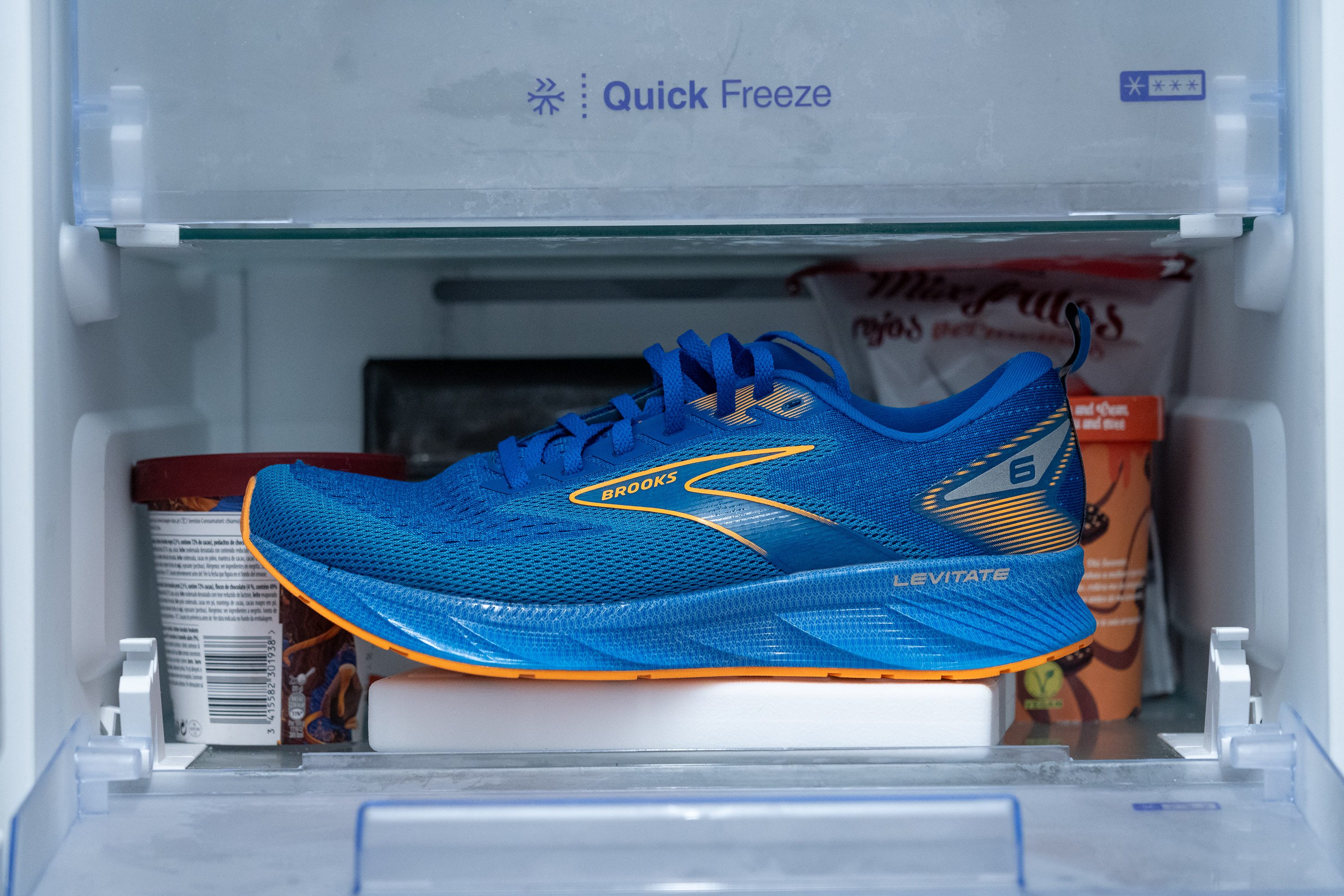
| Levitate 6 | 5% |
| Average | 24% |
Reflective elements
The Levitate 6 is emblazoned with a reflective element on the rear lateral side of each shoe that highlights its positions as sixth in the series. It’s not much, but it’s better than nothing, right? Not quite. We recommend sticking to well-lit routes and/or using additional high-vis gear during nocturnal sessions.
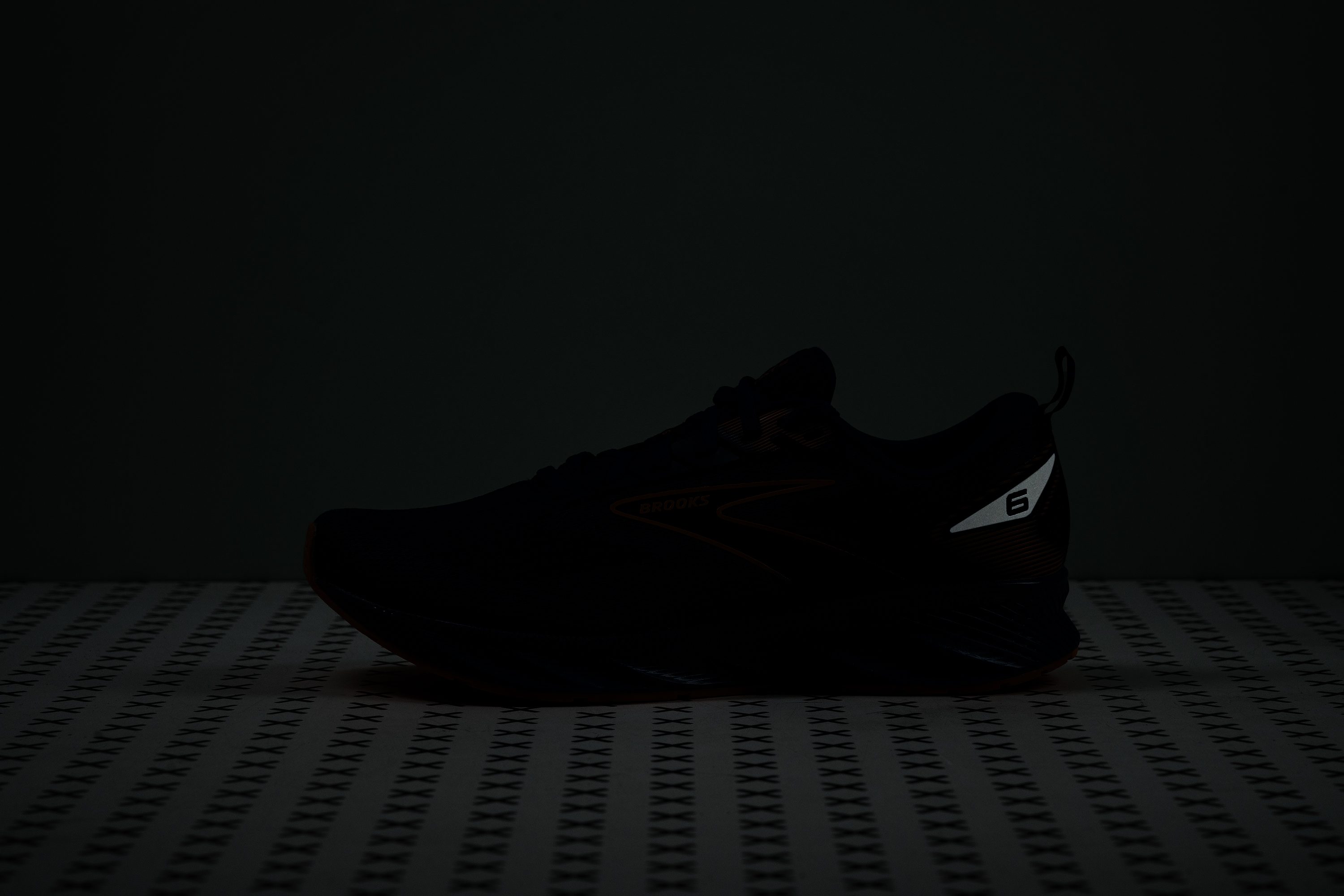
| Levitate 6 | Yes |
Tongue padding
The Levitate 6’s tongue isn’t as padded as our current lab average at only 4.5 mm thick according to our caliper. Nevertheless, we still felt plenty comfortable around the instep without any niggling signs of lace bite.

| Levitate 6 | 4.5 mm |
| Average | 5.8 mm |
Tongue: gusset type
Despite the Levitate 6’s tongue being non-gusseted, we didn’t face any problems with it slipping from side to side during our test runs.
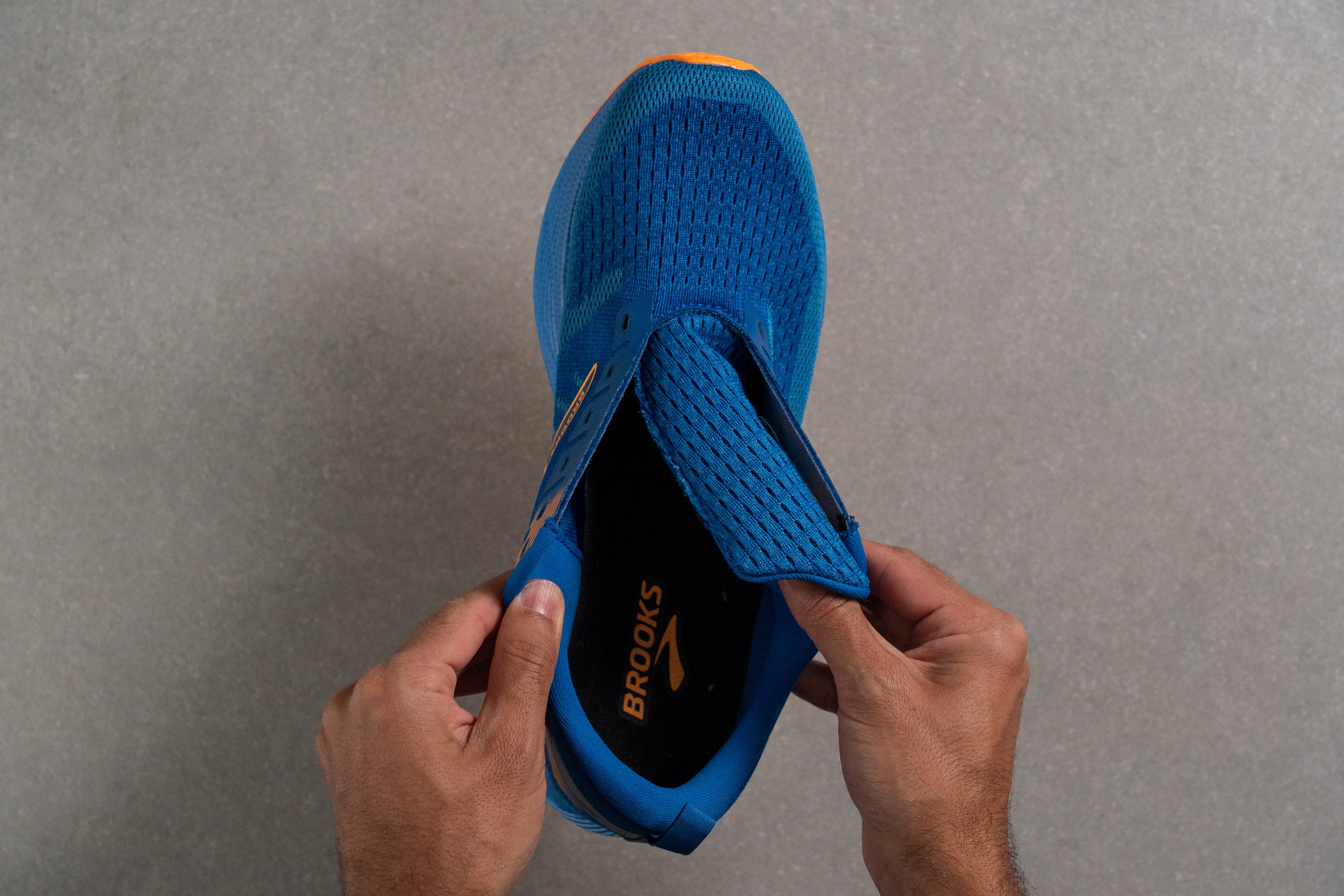
| Levitate 6 | None |
Heel tab
The Levitate 6 features a finger-loop on the heel tab which aids in easily sliding the shoe on and off.
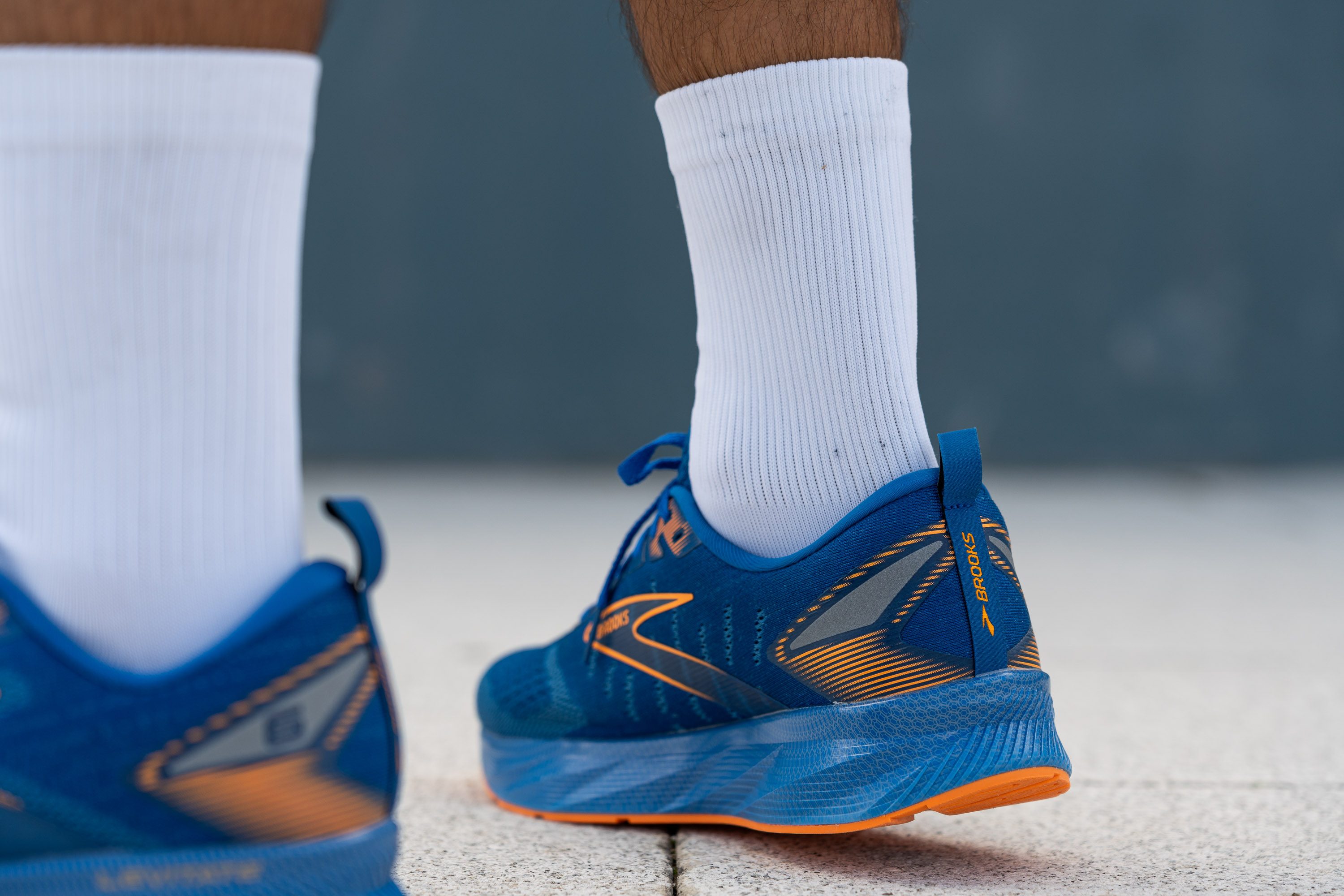
| Levitate 6 | Finger loop |

